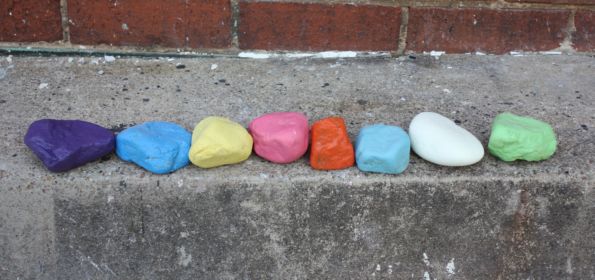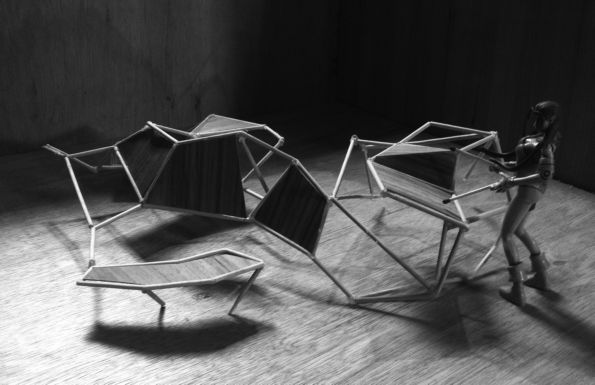Cherry blossom “5×5” project to exhibit 25 ground-breaking public art installations commissioned by artists from around the world.
By Anna Storm

Inspired by former slave Henry "Box" Brown, Wilmer Wilson IV's stage performance involves covering his body with postage stamps and walking into post offices, asking to be mailed.
Amid the marble corridors of one of DC’s more traditional bastions of art, the National Gallery of Art’s West Wing, hang works that are meant to endure. The light suffusing Turner’s seascapes and the finely rendered bows adorning Goya’s “Marquesa de Pontejos” have not only retained their evocative qualities, but have continued to delight for over a century. Thanks to modern preservation techniques, one can imagine these and other works by the NGA’s canonical masters thrilling generations of tourists, and District art history students, for centuries to come.
The public art installations spread throughout all eight of the capital’s wards this spring will not last centuries– they will barely last a month; but that’s precisely the point. Mayor Vincent Gray and the DC Commission on the Arts and Humanities awarded a $500,000 grant to five national and international curators this past winter, asking each to assemble a team of five artists for a large-scale public art initiative as part of this year’s Cherry Blossom Festival. The 25 artists of the “5 x 5” project have been tasked with creating 25 temporary public art installations, to be displayed for the duration of the festival that begins March 20th.
As the only local curator, hailing from Bethesda, MD, Laura Roulet sees a common thread interlinking the 25 pieces: they’re “all ephemeral.”
Roulet, herself an artist and author, has chosen to have her team of artists work through the concept of “relational aesthetics” in its quest to find art in the ephemeral. According to Roulet, the late 20th-century modern art theory is one in which “a temporary community is formed through the shared experience of an ephemeral art event.” Hence the emphasis on public performance, and audience participation, throughout the works of “Activate => Particpate,” Roulet’s title for her project within 5 x 5.
Wilmer Wilson IV, Ben Ashworth, the local artists who comprise The Floating Lab Collective, Charles Juhasz-Alvarado, and Patrick McDonough, are the five Active => Particpaters whom Roulet has chosen to convey the idea of “art as itinerary,” spreading throughout and utilizing as much of The District as possible in their personal installations.

Wilmer Wilson IV was inspired to tell the story of Henry "Box" Brown, an escaped slave who found freedom by paying to be shipped to the North. (Photo courtesy of Ben Ashworth's "Finding A Line" inspires youths to delve into skateboarding. (Photo courtesy of Dana Berkowitz)
Wilson in particular has incorporated the notion of the personal in his contribution, a three-stage performance inspired by the life of former slave Henry “Box” Brown. Both Brown and Wilson, a senior at Howard University and the youngest artist within 5 x 5, hailed from Richmond, VA. This hometown connection inspired Wilson to tell Brown’s story, that of an escaped slave who found freedom by paying to be shipped up North… in a crate. The “grotesque” story had “just always been with me since I was young,” says Wilson. “It’s a really absurd way to [have to] address a basic human need.”
Wilson’s performance, in which he also subjects himself to “uncomfortable conditions,” will see him covering his body with postage stamps and walking into three post offices throughout the city, asking to be mailed. A videographer will follow Wilson as he performs, as others are encouraged to, lending his one-shot, ephemeral act the posterity of a viewership. However, although his project for Activate => Particpate addresses a weighty subject, for the artist it is inherently “really beautiful. I think you can enjoy it as well.”

Patrick McDonough's project involves a scavenger hunt around the District. (Photo courtesy of Wilmer Wilson IV was inspired to tell the story of Henry "Box" Brown, an escaped slave who found freedom by paying to be shipped to the North. (Photo courtesy of Ben Ashworth's "Finding A Line" inspires youths to delve into skateboarding. (Photo courtesy of Dana Berkowitz)
Enjoyment is certainly part of Patrick McDonough’s project, an art-game that will use the modern trend of “geocaching” – a sort of scavenger hunt for the Technological Age – to engage participants in exploring regions of the capital they might have otherwise overlooked, as, like the broader 5 x 5 project, McDonough’s caches will be spread throughout all 8 wards.

Ben Ashworth's "Finding A Line" inspires youths to delve into skateboarding. (Photo courtesy of Dana Berkowitz)
For his part, Ben Ashworth is looking to bring a good time to kids in particular through his installation, “Finding A Line.” The artist plans to work with local youths to first clean an outdoor site for the purposes of developing a skate park, then to hold several workshops in which participants will learn how to build their own skateboards and how to edit video. The kids will then record themselves in the ephemeral act of skating, as well as in the process of enjoying the more lasting products of their hard work.
“Ephemeral” for the Floating Lab Collective will be demonstrated in the way the group seeks to challenge ideas of “traditional” museums by creating a moving museum in three parts. First meeting with communities to discuss what they believe makes an art object, and what should or should not be displayed in a museum as such, the artists will then ask to borrow some of the objects the communities hold to be culturally important. The final touch will see these everyday items placed on display in the Corcoran Gallery of Art – allowing the communities to “insert their museum into a ‘real’ museum,” as Roulet says.

Charles Juhasz-Alvarado will use cherry wood to create a xylophone. (Photo courtesy of Dana Berkowitz)
Finally as “the only outsider,” Puerto Rican Charles Juhasz-Alvarado is also the only one to be “inspired by the Cherry Blossom Festival,” says Roulet. Juhasz-Alvarado will use cherry wood to create a large, interactive xylophone in the shape of a cloud of cherry blossoms. Drumsticks will be made available for onlookers to interact, and play with the work.
Tellingly, after his piece has been installed, Juhasz-Alvarado will be flying back to Puerto Rico, not to return until the time comes to take the projects down. “Authorship is not the principle factor in defining art anymore,” explains Roulet. While the works of centuries’ old masters will continue to endure blocks away in the National Gallery of Art, for the viewers, participants, and curious passerby of Activate => Participate, “the experience is the artwork.”
The National Cherry Blossom Festival’s Centennial Celebration from March 20 – April 27, 2012. Information HERE.
